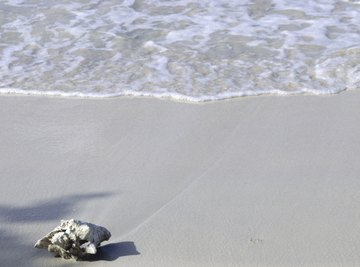
To varying degrees, living beings can adapt and adjust to environmental changes. Even shell-bearing sea organisms, many of which are considered sedentary and are hardly associated with “change,” have been shown to adapt, exploiting new chemicals that are dissolved in seawater and incorporating them into stronger shells. Ocean acidification, however, has meant an increase in the kinds of compounds that damage these creatures' defining shells and even impair the shells' formation.
The Chemistry Behind Ocean Acidification
Ocean water usually becomes acidic when non-acidic compounds in our environment react with seawater. Atmospheric carbon dioxide molecules combine with water molecules at the ocean's surface to produce an acid called carbonic acid. Similarly, nitrogen oxide and sulfur oxide, both present in fertilizer and later in water that runs off from farmland, combines with saltwater and makes nitric acid and sulfuric acid. These acids react with calcium carbonate, an essential mineral component of seashells.
The Damage Done to Existing Seashells
Because acids in the ocean break apart calcium carbonate, less calcium carbonate remains available for organisms like clams and mussels to build into their shells, or even corals into the skeletons that form reefs. This results in thinner shells and in some cases smaller shells that offer animals less protection. Professor Jean-Pierre Gattuso of France's National Centre for Scientific Research has estimated that, in 10 years, the Arctic Ocean could become acidic enough to actively dissolve creatures' existing shells.
The Effect on Shell Creation
Yet ocean acidification creates problems for shell-bearing organisms besides the corrosion of shells already created. Researcher George Waldbusser from Oregon State University has shown that higher amounts of carbon dioxide dissolved in seawater, which create more carbonic acid, can raise the energy cost of shell genesis and increase the difficulty oyster larvae have in establishing their shells during the crucial days after hatching. Without shells, the oysters fail to mature into their adult forms and eventually die.
The Concerns for Other Organisms
The concern reaches across ocean environments: without their protective shells, shell-bearing animals, from scallops to snails, cannot develop properly and will face greater threats from their surroundings. This, however, also affects those creatures that do not employ shells, as without their food sources, the sea mammals and fish that eat shelled animals may find their populations diminished. Even human beings, who depend on shellfish for food and build tourism around marine life, stand to be affected.
References
- Climate News Network: Acid Oceans Threaten Billion-Dollar Oyster Business
- Ocean Acidification International Coordination Centre: Arctic Ocean Acid "Will Dissolve Shells of Sea Creatures Within 10 Years"
- National Science Foundation: Acid Rain Has Disproportionate Impact on Near-Shore Ocean Waters
- National Oceanic and Atmospheric Administration: Carbon Dioxide and Our Ocean Legacy
About the Author
Sheila Johnson has been writing professionally since 2008. Her publication credits include work in the magazine "Marvel Spotlight" and in Salem Press' "Critical Survey of Graphic Novels." Johnson holds a Bachelor of Arts in English and a Bachelor of Science in biology from the University of Illinois at Chicago.
Photo Credits
DC Productions/Photodisc/Getty Images
